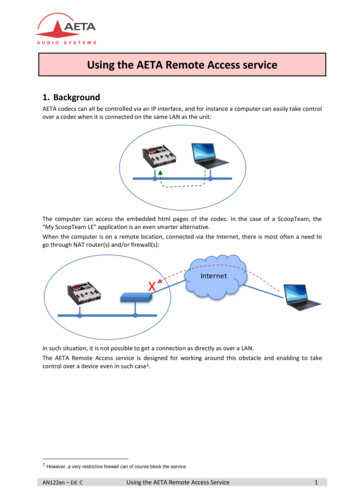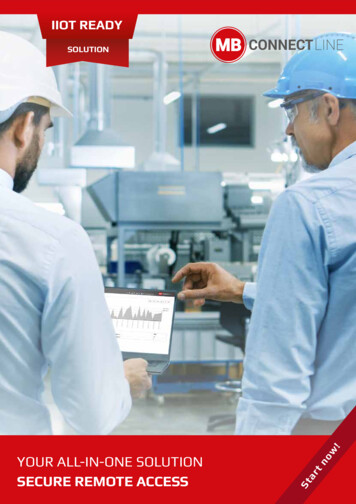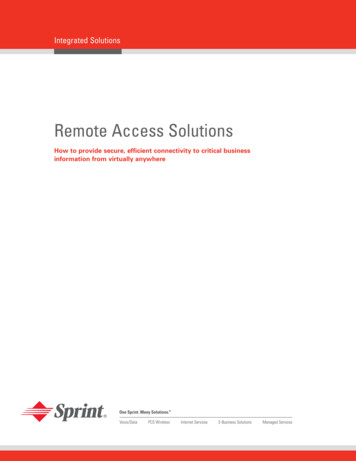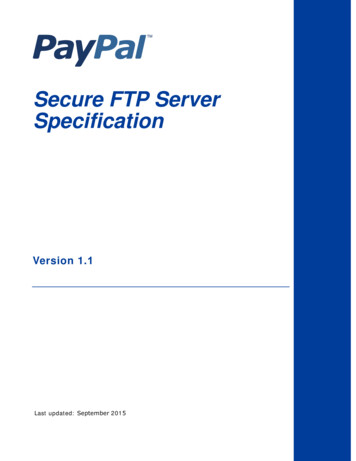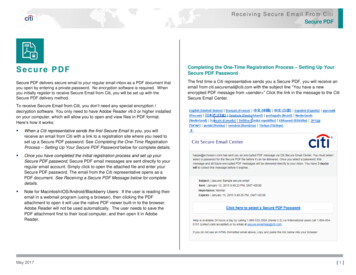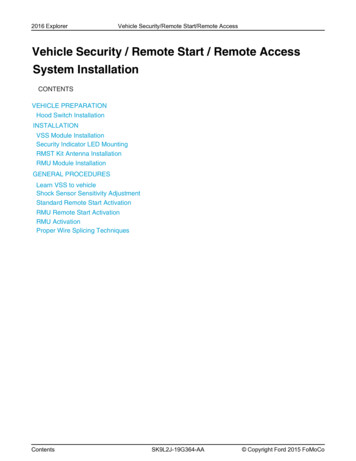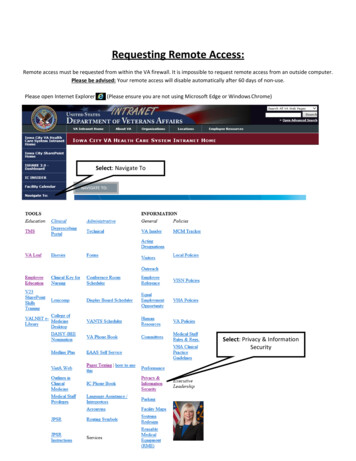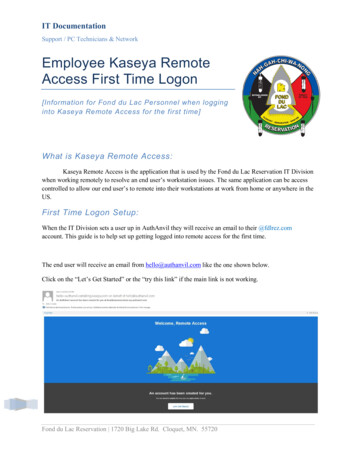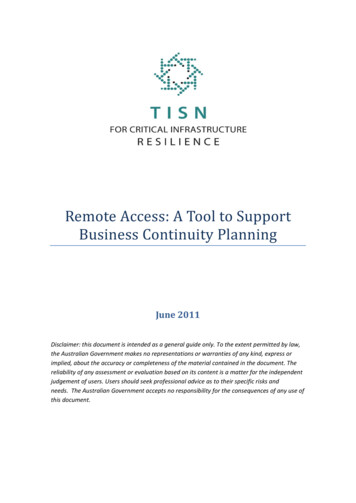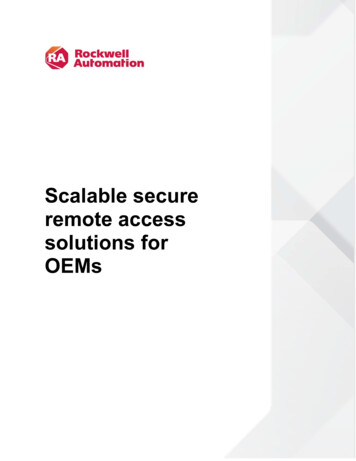
Transcription
Scalable secureremote accesssolutions forOEMs
IntroductionSecure remote access to production assets, data, and applications, along with the latest collaborationtools, provides plant and sites with the ability to apply the right skills and resources at the right time,independent of their physical location. OEMs are looking to reduce costs, add more value to theirIndustrial Automation and Control Systems (IACS) customers and differentiate themselves from theircompetitors. This paper outlines the means to enable secure remote access to plant or site-basedapplications & data and can be used as guidance for OEMs to collaborate with their customers whendesigning a secure remote access solution.Technical challengesOEMs have traditionally relied on deploying on-site personnel to provide support for IACS or usedmethods such as standalone dial-up access without using a firewall. This method of Remote Access oftencircumvents perimeter security, creates the threat of a “back door” into the IACS and can represent asignificant security risk. As OEMs want to provide secure support remotely, and respond to issues in realtime, this method is no longer sufficient.Technologies for remote access to traditional enterprise networks have been around for quite some time,such as Virtual Private Networks (VPNs). However, successfully applying technologies to provideeffective remote access to IACS has been a challenge.This is due to several reasons: IACS is often managed by Operational Technology (OT) organizations, while enterprise-levelremote access solutions such as VPNs are the responsibility of the Information Technology (IT)organization. Successful implementation of remote access to IACS requires collaborationbetween IT and OT organizations. Remote access can expose critical IACS components to various cybersecurity threats that maybe present on a remote or partner computer, potentially impacting production. It is challenging to confirm that the end device (computer) being used for remote access is secureand has the appropriate versions of the applications needed for remote access and control. Limiting the capabilities of the remote user to those functions that are appropriate and do notrequire local presence due to line-of-sight or other similar requirements can be difficult. OT organizations are often unable to limit a partner or remote employee’s access to only specificmachines, applications, or parts of the network for which they are responsible and haveauthorization. Solutions like the Stratix 4300 coupled with FactoryTalk Remote Access provide operation permission control with default roles (administrator, network security, deviceinstaller and device access) for user group management and asset management by folders.Furthermore, the solution provides an integrated firewall to restrict access to specific machines ordevices via VPN. One size does not fit all. An IACS remote access solution that works for one customer may not besufficient for another. An IACS remote access solution that is required by one customer may betoo burdensome or even impractical for another. As noted below, a viable remote access solutionis dependent upon industry requirements, customer requirements (security policies andprocedures), customer size and their support infrastructure.Rockwell Automation2Scalable secure remote access solutions for OEMs
As a result, remote access solutions, while widely deployed in the enterprise network, have not been aswidely adopted to support the IACS network. When VPN technology has been used, it has often beensubject to the previously mentioned challenges, and therefore limited to employees only (not partners),and can still result in some security risks, including cybersecurity threats and unauthorized access, if notproperly implemented. To truly achieve collaborative OT engineering, access needs to be scalable,regardless of location or company. Access needs to be secure to effectively communicate, diagnoseproblems and implement corrective actions. Access needs to be limited to those individuals that areauthorized to access systems and their authorized actions need to be aligned with IT and OT policies andprocedures.When collaborating with your customer to implement remote access to your IACS solutions (for example,machine), the following questions will help identify the organization’s level of readiness: Do they have an IT security policy? Do they have an IACS security policy? Do they have a remote access policy for employees and the infrastructure to support? What VPN technology/products do they use? Do they have a “partner” remote access policy - the ability and process to add partners (OEM, SI,automation vendor or contractor)? For partners, is your solution ready to be integrated into your customer’s IACS networkinfrastructure? Does your solution support remote access? Is your solution aligned withestablished IACS security standards such as ISA99 and NIST 800-82?Some other key considerations include: Monitoring and auditing activities of remote users to identify misuse Determine if there are any “line of site” (visual requirements) or other restrictions that need to beidentified before allowing certain remote access capabilities Define what software tools are allowed for remote accessRockwell Automation3Scalable secure remote access solutions for OEMs
Principals of secure remote accessDefense in depthWhen designing a secure remote accesssolution, a defense in depth approach shouldbe implemented. This approach creates multiplesecurity layers that address the differentpotential threats that could occur in a remoteaccess solution. Although there is no singletechnology or methodology that fully securesIACS networks, combining multiple securitytechnologies forms a strong deterrent to mostknown types of threats and security breaches,while limiting the impact of any compromise. Todeliver a comprehensive defense in depthsecurity program, companies need to rely onmultiple types of controls. These controls can becategorized as:Administrative Mostly security policies and procedures Examples include password policies,security awareness training, and so onTechnical Also called “logical” controls and consistof hardware, software, and electronicsto monitor and control access toinformation systems Examples include firewalls, IPS/IDS,smartcards, and so onPhysical Mostly mechanical controls to monitorand control physical access Examples include locks, securityguards, security cameras, and so onRockwell Automation4Scalable secure remote access solutions for OEMs
It’s important to remember that it’s not just about the technical controls and that a complete securityprogram includes administrative, technical and physical controls. The diagram above is an example oftechnical controls that can be implemented to create a defense in depth strategy.ApproachThere are several approaches to providing Secure Remote Access to an IACS, two of which are directand indirect access. The choice of these approaches is dependent upon the criteria previously noted suchas customer security policies and procedures. Each approach has several design considerations thatcould impact the proper operation of the IACS and should be accounted for in the design andimplementation of an IACS remote access solution.Direct accessDirect access allows the remote user to establish a secure connection “directly” to the IACS.After creating a secure VPN tunnel, the software on the remote user’s computer, initiatescommunication directly with the IACS. Design considerations – how will these be enforced?oNetwork and application authentication and authorizationoChange management, version control, regulatory compliance and software licensemanagementoHealth management of the remote client (computer)oAlignment with established IACS security standardsNOTE: Though little to no IT support is required when following this approach, best securitypractices should be in alignment with established IACS security standards.Indirect accessIndirect access allows the remote user to establish a secure connection to the IACS through anintermediary server usually residing in the DMZ (Demilitarized Zone) providing remote gateway access toa remote access server (RAS) in the IACS. The remote client uses either a thin client software applicationor a web browser to establish a connection to the RAS once the VPN session has been established.Rockwell Automation5Scalable secure remote access solutions for OEMs
Design considerationsoMultiple layers of network authentication and authorizationoSimplified asset management – change management, version control, regulatorycompliance and software license managementoSimplified health management of the remote clientoGreater alignment with established IACS security standardsNOTE: Indirect access is often considered a more secure approach due to greater alignment with IACSsecurity standards. This is due in part to having a dedicated asset, such as a computer, within the IACSused for remote access.When analyzing secure remote access solutions, you must determine whether thetype of system that needs to be accessed, are standalone isolated IACS or an enterpriseintegrated IACS. Standalone isolated IACS representative exampleoSmall plant or site, could be small single-operator shops, remote location (not enterpriseintegrated) with few automated machinesoLittle to no IT support with minimal to no security policiesoLittle to no alignment with established IACS security standardsoStandalone or integrated OEM machines and equipmentEnterprise-Integrated IACS Representative ExampleoLarger plant or siteoIndustrial network interfaces with the enterprise networkoStrong IT presence with defense in depth security policiesoAlignment with established IACS security standardsRockwell Automation6Scalable secure remote access solutions for OEMs
Example: Direct access for standalone IACSExample: Indirect access for standalone IACSExample: Indirect access for enterprise-integrated IACS(Large plant or site with OT and IT system integration)Rockwell Automation7Scalable secure remote access solutions for OEMs
Remote access solutionsRemote Access for Industrial EquipmentRemote Access for Industrial Equipment is a hardware and software solution to enable remoteconnectivity. This solution requires both FactoryTalk Remote Access software and the Stratix 4300Remote Access Router to support customers in applyingthe appropriate technical resources while independent ofphysical location. These products enable remoteconnectivity to remote systems and applications whentravel is not feasible to provide in-person support forinstallation, programming updates, and on-demandtroubleshooting and maintenance.FactoryTalk Remote Access is the web-based client usedto configure and manage remote connections to theStratix 4300 Remote Access Router. FactoryTalk RemoteAccess software allows users to configure operationpermission policies, user group management and assetmanagement. The Stratix 4300 router is offered in two and five 10/100/1000 Mbps Gigabit Ethernetcopper port variants to allow access to remote systems and its subnetworks. A customer can use theseproducts to meet their connectivity needs.Connection out from the plant (Stratix 4300)End-user initiated connections can also provide secure remote access capabilities provided the controlsystem has personnel on-site and that there is already secure internet connectivity established usingmulti-layer security controls.The risk of opening outbound connections to the internet (http/https) to use such services should not beoverlooked and should be restricted to certain sites and IP addresses to help prevent browsing the webfrom the control systems. The use of web browsers can pose significant risk and have been known to bea source of attacks.Rockwell Automation8Scalable secure remote access solutions for OEMs
Another solution is a gateway VPN remote access router, such as the Stratix 4300, which resides in thecontrol system and establishes remote access through a hosted VPN service. Care should be taken withthis solution to analyze the hosted service provider, their location and whether they are adhering to bestsecurity practices. It is also important that the gateway VPN is aligned with established IACS securitystandards, such as ISA99 and NIST 800-82, and meets the security requirements of the manufacturer’ssecurity policy.Remote connection into the plant (WAN routers/modems:DSL, cellular, satellite, cable, T1’s, and so on)When traditional modems are not an option due to the infeasibility of installing phone lines,cellular access to establish a WAN connection provides an excellent alternative. This is becominga popular option due to the increasing, speed, affordable cost, and convenience.However, as stated above regarding dial-in modems, cellular WAN connections using cellular modemsand routers should be used with other security technologies to provide defense in depth or at a minimumhave these features built into the device (firewall bundle). Other WAN connectivity options include DSL,Cable, T1’s, Satellite, and so on. The type of connectivity that will be used to establish WAN connectivityto the standalone system will be dependent upon the plant or site location, budget constraints, andaccess policy. One thing to note is that when implementing a VPN, typically a static IP address wouldneed to be assigned by the WAN provider. The following are some security features to look for when designing a solution: Does it have VPN capabilities, SSL or IPsec? Does it provide a firewall?oDoes it filter industrial protocols like CIP , Modbus and so on? NAT (Network Access Translation)? Is it built for industrial use? Can it provide auditing? Does it have an intrusion detection and/or prevention system?Rockwell Automation9Scalable secure remote access solutions for OEMs
Enterprise-Integrated IACS Rockwell Automation & Cisco: Securely Traversing IACS Data across the Industrial DemilitarizedZone Design and Implementation c/groups/literature/documents/td/enet-td009 en-p.pdfDirect Access Solutions Rockwell Automation provides a secure remote access solution used for outbound connectionsfrom the plant or site. This solution includes the Stratix 4300 remote access routerorok.auto/stratix4300Customized Solutions For customized solutions, The Rockwell Automation Industrial Maintenance & Support Servicecan design a secure solution that meets your yThe evolution of secure remote access capabilities allows OEMs to improve productivity, reduce cost andrespond more quickly to events that impact their customer. By using these secure remote accesssolutions, the OEMs can provide real-time remote support. These capabilities are increasingly importantas manufacturing operations become more complex and globally distributed while the availability ofskilled workers to support systems on-site on a 24-hour basis is decreasing. The remote accesscapabilities for standalone systems give OEMs the ability to apply the right skills and resources at theright time, independent of their physical location. This allows for higher efficiency, less downtime andlower cost.Given the critical nature of IACS applications, however, it’s important that any remote access solutionprovides the appropriate levels of security to meet the needs of the manufacturer and align withestablished IACS security standards. Applying the principles of defense in depth confirms that there isnever direct unsecure remote access to an IACS application.Glossary of TermsCIP - Common Industrial ProtocolThe Common Industrial Protocol (CIP) encompasses a comprehensive suite of messages and servicesfor the collection of manufacturing automation applications – control, safety, synchronization, motion,configuration and information. CIP is owned and maintained by ODVA. ODVA is an internationalRockwell Automation10Scalable secure remote access solutions for OEMs
association comprising members from the world’s leading automation companies.DMZ - Demilitarized ZoneRefers to a buffer or network segment between two network zones. A DMZ is commonly found between acorporate network and the internet where data and services can be shared/accessed from users in eitherthe internet or corporate networks. A DMZ is typically established with network firewalls to manage andsecure the traffic from either zone.IACS - Industrial Automation and Control SystemsRefers to the set of devices and applications used to automate and control the relevant manufacturingprocess. Rather than use various terms with a similar meaning (for example, production systems andplant floor systems, we standardized on this term for use in this paper). That is not to suggest any specificfocus or limitations. We intend that the ideas and concepts outline herein are applicable in various typesof manufacturing including but not limited to batch, continuous, discrete, hybrid and process. Otherdocuments and industry references may refer to Industrial Control Systems (ICS). For this document,those terms are interchangeable. This document uses IACS, as reflected in the ISA99 standards, and isaligned with the Cisco and Rockwell Automation Converged Plantwide Ethernet (CPwE)IP Protocol SuiteA set of networking standards on which the internet and most enterprise networking is based. It includesthe Layer 3 Internet Protocol (IP), the Layer-4 Transmission Control Protocol (TCP) and User DatagramProtocol (UDP).IPS - Intrusion Prevention SystemsA network security device that monitors network activity for malicious or unwanted behavior.IPSec - IP SecurityA framework of open standards that provides data confidentiality, data integrity and data authenticationbetween participating peers. IPSec provides these security services at the IP layer. IPSec uses IKE (seeabove) to handle the negotiation of protocols and algorithms based on local policy and to generate theencryption and authentication keys to be used by IPSec. IPSec can help protect one or more data flowsbetween a pair of hosts, between a pair of security gateways or between a security gateway and a host.Manufacturing Zone (Plant or Site)A network zone in the Plant Logical Framework as shown in Chapter 2 of the Cisco and RockwellAutomation Converged Plantwide Ethernet (CPwE) Design and Implementation Guide. The zone containsthe complete set of applications, systems, infrastructure, and devices that are critical to the continuedoperations of the plant. In other documentation (for example, ISA99), this zone may also be referred to asthe Control zone. The terms are interchangeable in this regard.NAT - Network Address TranslationMechanism for reducing the need for globally unique IP addresses. NAT allows an organization withaddresses that are not globally unique to connect to the internet by translating those addresses intoglobally routable address space.Remote Terminal SessionRemote desktop refers to a set of protocols and software that enable one computer or user to remotelyaccess and control another computer through graphical Terminal Emulation. Software that makes it,appears to a remote host as a directly attached terminal, including the Microsoft RDP, Remote DesktopProtocol and VNC Virtual Network Computing.SSL - Secure Socket LayerEncryption technology for the Web used to provide secure transactions, such as the transmission of creditRockwell Automation11Scalable secure remote access solutions for OEMs
card numbers for ecommerce.Subnet or SubnetworkIn IP networks, a subnet is a network sharing a particular subnet address. Subnetworks are networksarbitrarily segmented by a network administrator to provide a multilevel, hierarchical routing structurewhile shielding the subnetwork from the addressing complexity of attached networks.VPN - Virtual Private NetworkA network that uses primarily public telecommunication infrastructure, such as the internet, to provideremote offices or traveling users an access to a central organizational network. VPNs typically requireremote users of the network to be authenticated, and often secure data with encryption technologies tohelp prevent disclosure of private information to unauthorized parties. VPNs may serve any networkfunctionality that is found on any network, such as sharing of data and access to network resources,printers, databases, websites and so on. A VPN user typically experiences the central network in amanner that is identical to being connected directly to the central network. VPN technology via the publicinternet has replaced the need to requisition and maintain expensive dedicated leased-linetelecommunication circuits once typical in wide-area network installations.WAN - Wide Area NetworkA wide area network (WAN) is a telecommunication network that covers a broad area (that is, anynetwork that links across metropolitan, regional or national boundaries). Business and governmententities utilize WANs to relay data among employees, clients, buyers and suppliers from variousgeographical locations. In essence, this mode of telecommunication allows a business to effectivelyconduct its daily function regardless of location.FactoryTalk Remote Access, Rockwell Automation and Stratix are trademarks of Rockwell Automation, Inc. Trademarks not belonging to Rockwell Automation are property of their respectivecompanies.Publication ENET-WP025B-EN-P — January 2022 Supersedes Publication ENET-WP025A-EN-P — March 2015Copyright 2022 Rockwell Automation, Inc. All rights reserved. Printed in USA.Rockwell Automation12Scalable secure remote access solutions for OEMs
Remote Access for Industrial Equipment is a hardware and software solution to enable remote connectivity. This solution requires both FactoryTalk Remote Access software and the Stratix 4300 Remote Access Router to support customers in applying the appropriate technical resources while independent of
